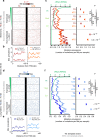Global unleashing of transcription elongation waves in response to genotoxic stress restricts somatic mutation rate
- PMID: 29233992
- PMCID: PMC5727188
- DOI: 10.1038/s41467-017-02145-4
Global unleashing of transcription elongation waves in response to genotoxic stress restricts somatic mutation rate
Abstract
Complex molecular responses preserve gene expression accuracy and genome integrity in the face of environmental perturbations. Here we report that, in response to UV irradiation, RNA polymerase II (RNAPII) molecules are dynamically and synchronously released from promoter-proximal regions into elongation to promote uniform and accelerated surveillance of the whole transcribed genome. The maximised influx of de novo released RNAPII correlates with increased damage-sensing, as confirmed by RNAPII progressive accumulation at dipyrimidine sites and by the average slow-down of elongation rates in gene bodies. In turn, this transcription elongation 'safe' mode guarantees efficient DNA repair regardless of damage location, gene size and transcription level. Accordingly, we detect low and homogenous rates of mutational signatures associated with UV exposure or cigarette smoke across all active genes. Our study reveals a novel advantage for transcription regulation at the promoter-proximal level and provides unanticipated insights into how active transcription shapes the mutagenic landscape of cancer genomes.
Conflict of interest statement
The authors declare no competing financial interests.
Figures







Similar articles
-
RNA polymerase II is released from the DNA template during transcription-coupled repair in mammalian cells.J Biol Chem. 2018 Feb 16;293(7):2476-2486. doi: 10.1074/jbc.RA117.000971. Epub 2017 Dec 27. J Biol Chem. 2018. PMID: 29282293 Free PMC article.
-
Continuous transcription initiation guarantees robust repair of all transcribed genes and regulatory regions.Nat Commun. 2020 Feb 14;11(1):916. doi: 10.1038/s41467-020-14566-9. Nat Commun. 2020. PMID: 32060325 Free PMC article.
-
Blockage of RNA polymerase II at a cyclobutane pyrimidine dimer and 6-4 photoproduct.Biochem Biophys Res Commun. 2004 Aug 6;320(4):1133-8. doi: 10.1016/j.bbrc.2004.06.066. Biochem Biophys Res Commun. 2004. PMID: 15249207
-
Recurrent Noncoding Mutations in Skin Cancers: UV Damage Susceptibility or Repair Inhibition as Primary Driver?Bioessays. 2019 Mar;41(3):e1800152. doi: 10.1002/bies.201800152. Epub 2019 Feb 25. Bioessays. 2019. PMID: 30801747 Free PMC article. Review.
-
Role of genome guardian proteins in transcriptional elongation.FEBS Lett. 2016 Apr;590(8):1064-75. doi: 10.1002/1873-3468.12152. Epub 2016 Apr 4. FEBS Lett. 2016. PMID: 27010360 Review.
Cited by
-
Genome-wide mapping of nucleotide excision repair with XR-seq.Nat Protoc. 2019 Jan;14(1):248-282. doi: 10.1038/s41596-018-0093-7. Nat Protoc. 2019. PMID: 30552409 Free PMC article.
-
Active mRNA degradation by EXD2 nuclease elicits recovery of transcription after genotoxic stress.Nat Commun. 2023 Jan 20;14(1):341. doi: 10.1038/s41467-023-35922-5. Nat Commun. 2023. PMID: 36670096 Free PMC article.
-
Integrating the DNA damage and protein stress responses during cancer development and treatment.J Pathol. 2018 Sep;246(1):12-40. doi: 10.1002/path.5097. Epub 2018 Jul 19. J Pathol. 2018. PMID: 29756349 Free PMC article. Review.
-
Feeling the force from within - new tools and insights into nuclear mechanotransduction.J Cell Sci. 2025 Mar 1;138(5):JCS263615. doi: 10.1242/jcs.263615. Epub 2025 Mar 10. J Cell Sci. 2025. PMID: 40059756 Review.
-
AFF1 acetylation by p300 temporally inhibits transcription during genotoxic stress response.Proc Natl Acad Sci U S A. 2019 Oct 29;116(44):22140-22151. doi: 10.1073/pnas.1907097116. Epub 2019 Oct 14. Proc Natl Acad Sci U S A. 2019. PMID: 31611376 Free PMC article.
References
Publication types
MeSH terms
Substances
LinkOut - more resources
Full Text Sources
Other Literature Sources
Molecular Biology Databases

